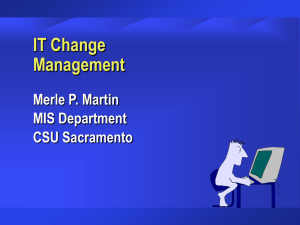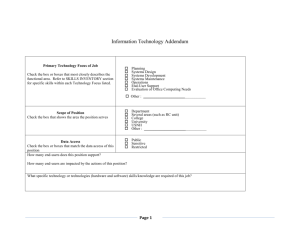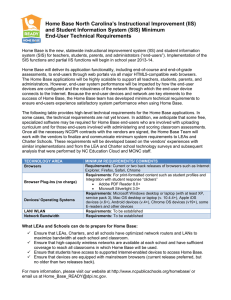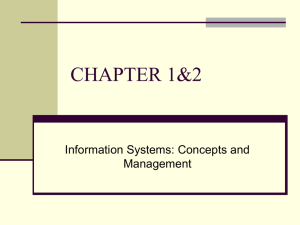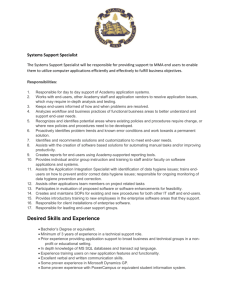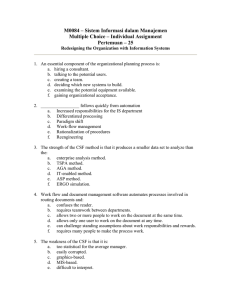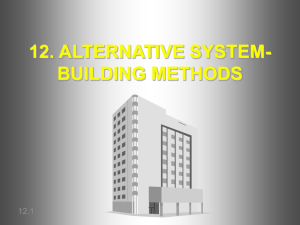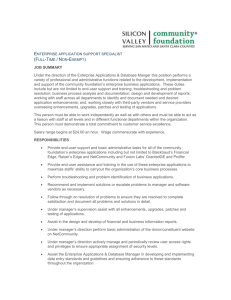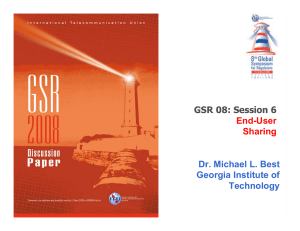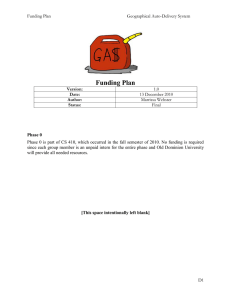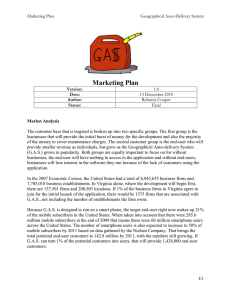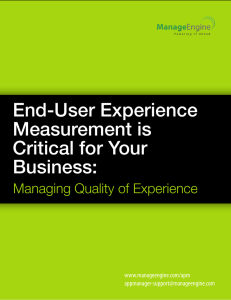IT Change 2
advertisement
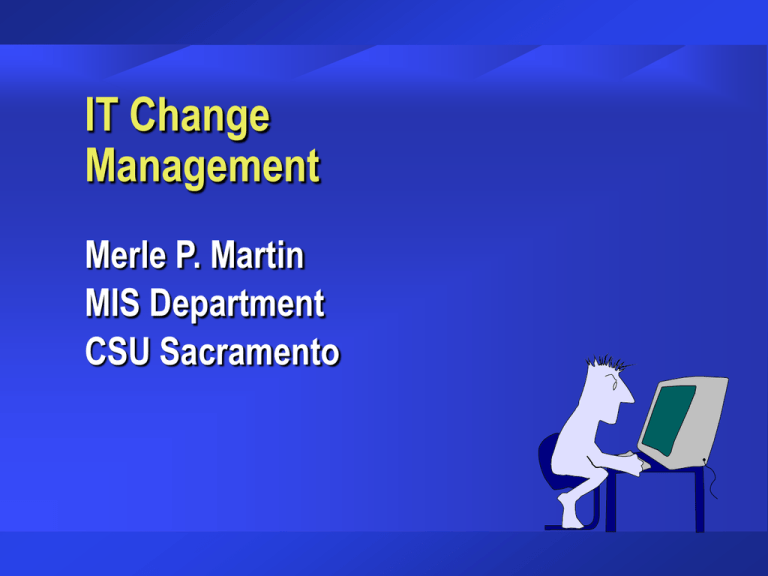
IT Change Management Merle P. Martin MIS Department CSU Sacramento Agenda Challenge of change Change process identify need describe assess environment position move forward Critical Success Factors Dilbert Change “People hate change, and with good reason. Change makes us stupider, relatively speaking. Change adds new information to the universe; information we don’t know. Our knowledge - as a percentage of all the things that we know - goes down a tick every time something changes.” Dilbert Principle, pg 18 Challenge of Change Disrupts frames of reference Presents a future where past experiences do not hold true What value seniority? Engenders reluctance to IT change Positive Impacts Improved jobs; opportunities, satisfaction, conditions, pay Improved product quality, cycle time, convenience, cost Competitive advantage Increasing productivity, health, leisure time, educational opportunity Negative Impacts Degraded jobs; opportunities, satisfaction, conditions, pay Increased costs, risks Unwanted side effects Changes to business processes Obsolete skills, experience Impact on business partners Changed economic models Types of Resistance Avoidance: pretend new systems don’t exist maintain informal / redundant record-keeping systems Projection: blame all application problems on new system Resistance (Cont.) Hostility: users antagonistic particularly to advocates of new system Sabotage: try to make new system fail High Change Low Change Business Business / Technology Rate of Change Low Change High Change Technology Change Management Measuring Performance Monitoring Readiness for Change Communicating Engaging Stakeholders Organizing for Change FEB JAN Leading Change Planning for Transition •IT Change Process Identify need for change Describe the change Assess change environment Position for change Move forward Follow up Identify Need “When it is not necessary to change, it is necessary not to change.” Result of IT top-down, strategic planning Beware of Law of Hammer “Give a kid a hammer, and you’ll be surprised what needs to be hammered” Develop Need Point out alternatives to existing problem Dramatize end-users importance in solving problem Convince end-users they are capable of solving problem Describe Change What Why (strategic plan) Who (stakeholders) Where (geographic / level of organization) When (preliminary) Assess Environment AMS identifies people who can accelerate, slow, or block change initiative. Who: is driving initiative? seems to be resisting? is empowered to make decisions? can make change succeed or fail? AMS People WHO: will be affected by the change? will take an interest in change and its effects (e.g., regulators and public)? will be responsible for change when implemented? Department Approach Carey studied different organizations’ success in implementing change Found 4 significant factors rigidity commitment to status quo knowledge of status quo exposure to change Rigidity Behavioral-rigidity scores on standard personality test Prohibited as hiring factor Can offset rigid mindset by: changing in stages measure by department introduce change in less rigid departments Commitment to Status Quo More commitment, more resistance to change Make status quo unattractive: higher chargeback rate Make change attractive enhance (sell) image increase status of those who use it Knowledge of Status Quo Length of time worked with old IT Supervisors, managers Surround strategy implement change elsewhere peer pressure Exposure to Change More exposure, more positive attitudes to change Early indoctrination, training Prototyping Issue This is the era of continual change. Therefore, we can expect reduced resistance to technological changes? Do you agree? Why or why not? Position for Change Create steering committee Establish change goals Design measurement system Establish project management system Position for Change Establish change team credibility Design training program Begin to sell change Design change communication system Change Team Credibility Establish credibility in competence honesty objectivity empathy Selling Change Secure end-user commitment Assume end-user perspective Address end-user concerns Secure End-user Commitment Build user competence Make changes easier Human Factors Training Making Change Possible Change agent IT Make system more usable EndChange users Acquire knowledge & skills Assume End-User Perspective Go to end-user work areas Use end-user oriented tools Play the role of the end-user The Memo exercise Selling Change Ferguires (1991) Areas of end-user concern Relative Advantage: What’s in it for me? How will my relative position be enhanced by this change? Selling Change Compatibility: What is the same in the new and old systems? What won’t I have to learn? Complexity: How long is the learning curve? Will I be able to learn the new system? How long will it take? Selling Change Try-ability: Can I try it before I commit? Prototyping Observability: Can I see it in action? Who else is using it? Do they like it? Communication System “Communication about change is a lot like a wooden hamburger. If you put enough garnish on it, somebody is going to swallow it.” Dilbert Need honest communication system Honest Communication System Where did we say we’d be? Where are we now? What’s the difference? Why? How will we solve this problem? What’s our new prognosis? Issue What experiences have you had in good or bad communication in a change situation? What would you have done differently? Move Forward Measure / communicate results Freeze positive behavior by rewarding change Continuous (not ad-hoc) training Shift from user reliance to self reliance Move Forward Reduce resistance by: user involvement prototyping user feedback Repeat steps, if necessary Implementation method Use end-users to spread commitment Freeze Positive Behavior Give rewards for change latest equipment off-site training Establish continuous training rather than ad-hoc Shift from Reliance to Self Reliance Make end-users less reliant on you Sacrifice your ego Build end-user ownership “Old change-agents never die; they just fade away.” Use End-users to Spread Commitment Identify / select leaders Assign them to steering committees Assign them to project teams Critical Success Factors Senior management commitment Be sensitive to people issues Set aggressive improvement targets Critical Success Factors Look to top performers for selling change Measure and communicate Instill a sense of ownership of the change by those undergoing the change Discussion Doug Busch Manager of Intranet Operations Intel Points to Remember Challenge of change Change process Critical Success Factors
